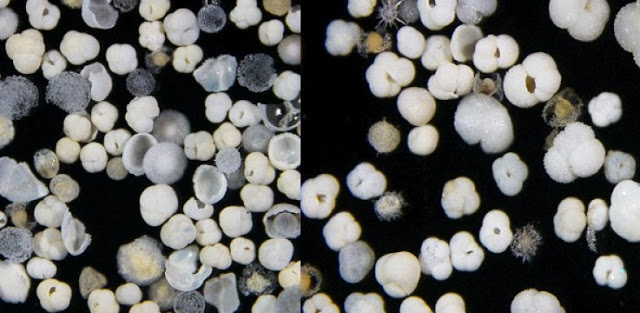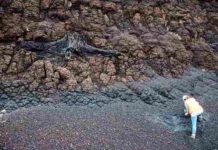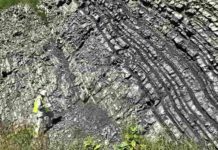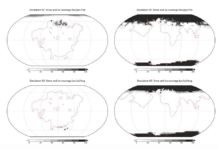
A new study of the relationship between ocean currents and climate change has found that they are tightly linked, and that changes in the polar regions can affect the ocean and climate on the opposite side of the world within one to two hundred years, far quicker than previously thought.
The study, by an international team of scientists led by the University of Cambridge, examined how changes in ocean currents in the Atlantic Ocean were related to climate conditions in the northern hemisphere during the last ice age, by examining data from ice cores and fossilised plankton shells. It found that variations in ocean currents and abrupt climate events in the North Atlantic region were tightly linked in the past, and that changes in the polar regions affected the ocean circulation and climate on the opposite side of the world.
The researchers determined that as large amounts of fresh water were emptied into the North Atlantic as icebergs broke off the North American and Eurasian ice sheets, the deep and shallow currents in the North Atlantic rapidly slowed down, which led to the formation of sea ice around Greenland and the subsequent cooling of the Northern Hemisphere. It also strongly affected conditions in the South Atlantic within a matter of one to two hundred years. The results, published in the journal Nature Geoscience, show how climate events in the Northern Hemisphere were tightly coupled with changes in the strength of deep ocean currents in the Atlantic Ocean, and how that may have affected conditions across the globe.
During the last ice age, which took place from 70,000 to 19,000 years ago, the climate in the Northern Hemisphere toggled back and forth between warm and cold states roughly every 1000 to 6000 years. These events, known as Dansgaard-Oeschger events, were first identified in data from Greenland ice cores in the early 1990s, and had far-reaching impacts on the global climate.
The ocean, which covers 70% of the planet, is a huge reservoir of carbon dioxide and heat. It stores about 60 times more carbon than the atmosphere, and can release or take up carbon on both short and long timescales. As changes happen in the polar regions, they are carried around the world by ocean currents, both at the surface and in the deep ocean. These currents are driven by winds, ocean temperature and salinity differences, and are efficient at distributing heat and carbon around the globe. Ocean currents therefore have a strong influence on whether regions of the world are warm (such as Europe) or whether they are not (such as Antarctica) as they modulate the effects of solar radiation. They also influence whether CO2 is stored in the ocean or the atmosphere, which is very important for global climate variability.
“Other studies have shown that the overturning circulation in the Atlantic has faced a slowdown during the last few decades,” said Dr Julia Gottschalk of Cambridge Department of Earth Sciences, the paper’s lead author. “The scientific community is only beginning to understand what it would mean for global climate should this trend continue, as predicted by some climate models.”
Analysing new data from marine sediment cores taken from the deep South Atlantic, between the southern tip of South America and the southern tip of Africa, the researchers discovered that during the last ice age, deep ocean currents in the South Atlantic varied essentially in unison with Greenland ice-core temperatures. “This implies that a very rapid transmission process must have operated, that linked rapid climate change around Greenland with the otherwise sluggish deep Atlantic Ocean circulation,” said Gottschalk. Best estimates of the delay between these two records suggest that the transmission happened within about 100 to 200 years.
Digging through metres of ocean mud from depths of 3,800 metres, the team studied the dissolution of fossil plankton shells that was closely linked to the chemical signature of different water masses. Water masses originating in the North Atlantic are less corrosive than water masses from the South Atlantic.
“Periods of very intense North Atlantic circulation and higher Northern Hemisphere temperatures increased the preservation of microfossils in the sediment cores, whereas those with slower circulation, when the study site was primarily influenced from the south, were linked with decreased carbonate ion concentrations at our core site which led to partial dissolution,” said co-author Dr Luke Skinner, also from Cambridge’s Department of Earth Sciences.
To better understand the physical mechanisms of rapid ocean adjustment, the data was compared with a climate model simulation which covers the same period. “The data of the model simulation was so close to the deep ocean sediment data, that we knew immediately, we were on the right track,” said co-author Dr Laurie Menviel from the University of New South Wales, Australia, who conducted the model simulation.
The timescales of these large-scale adjustments found in the palaeoceanographic data agree extremely well with those predicted by the model. “Waves between layers of different density in the deep ocean are responsible for quickly transmitting signals from North to South. This is a paradigm shift in our understanding of how the ocean works,” said Axel Timmermann, Professor of Oceanography at the University of Hawaii.
Although conditions at the end of the last ice age were very different to those of today, the findings could shed light on how changing conditions in the polar regions may affect ocean currents. However, much more research is needed in this area. The study’s findings could help test and improve climate models that are run for both past and future conditions.
The sediment cores were recovered by Dr Claire Waelbroeck and colleagues aboard the French research vessel Marion Dufresne.
The research was supported by the Gates Cambridge Trust, the Natural Environmental Research Council of the UK, the Royal Society, the European Research Council, the Australian Research Council and the National Science Foundation of the United States of America.
Reference:
Julia Gottschalk, Luke C. Skinner, Sambuddha Misra, Claire Waelbroeck, Laurie Menviel, Axel Timmermann. Abrupt changes in the southern extent of North Atlantic Deep Water during Dansgaard–Oeschger events. Nature Geoscience, 2015; DOI: 10.1038/ngeo2558
Note: The above post is reprinted from materials provided by University of Cambridge. The original story is licensed under a Creative Commons Licence.










